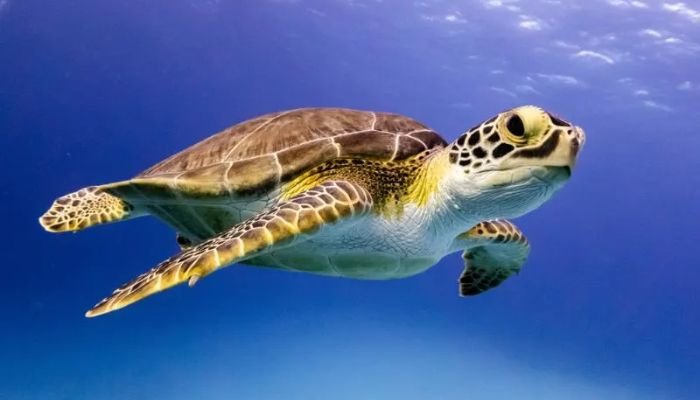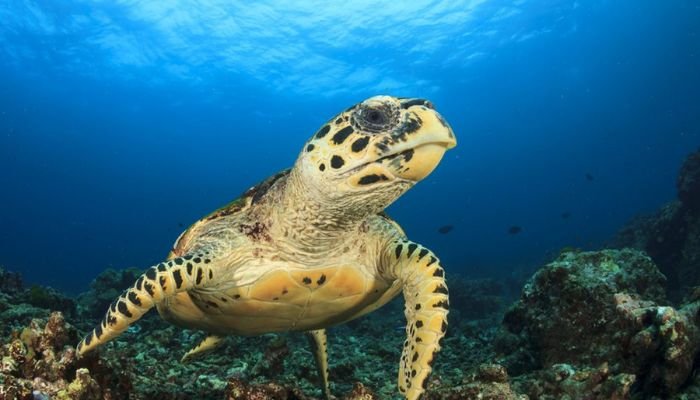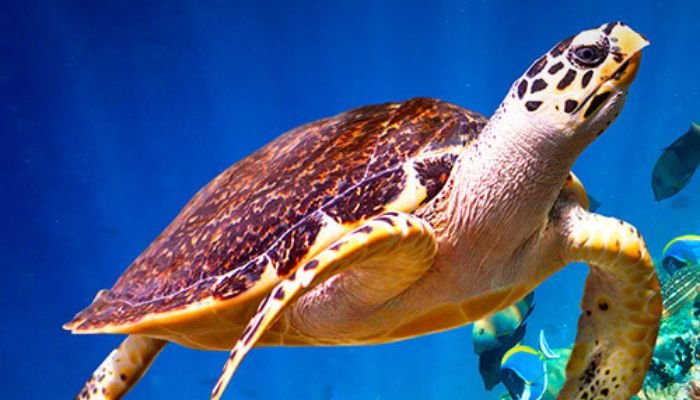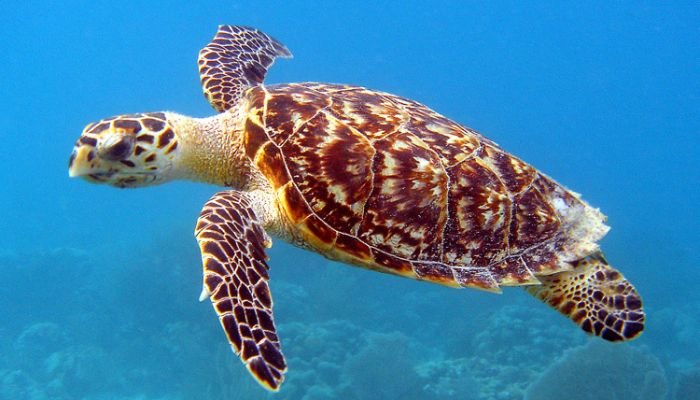
In tropical and subtropical waters around the globe, the Hawksbill Sea Turtle is a marine reptile that is gravely endangered. It is an intriguing species with a beak-like mouth and an exquisitely patterned shell. The consumption of sponges by hawksbill turtles substantially contributes to the resilience of coral reef ecosystems. They are unfortunately threatened by a number of factors, including habitat loss, pollution, and illicit trade. Conservation efforts are presently underway to protect these magnificent reptiles and guarantee their survival for future generations.. Here are Hawksbill sea turtle Guide on Food, Habitat, Size, Lifespan & Predators below-
Hawksbill Sea Turtle Stats in Table Format
The stats are given below for Hawksbill sea turtle
| Reptiles List | Hawksbill sea turtle |
|---|---|
| Family | Cheloniidae |
| Type | Turtle |
| Size | Medium to Large |
| Length | Hawksbill sea turtle: Up to 2-3 feet (0.6-0.9 meters) |
| Color | Hawksbill sea turtle: Typically has a brownish or dark brown coloration. |
| Weight | Hawksbill sea turtle: Adult hawksbill sea turtles can weigh between 100 to 150 pounds.. |
| Lifespan | 30-50 years (or more) |
| Reproduction | Oviparous, lays eggs |
| Gestation Periods | 60-90 days |
| Endangered Status | Critically Endangered (IUCN Red List) |
| Features | Distinctive pattern on the shell, sharp beak-like mouth |
| Country & Areas | Found in tropical and subtropical waters of the Atlantic, Pacific, and Indian Oceans, including the Caribbean and Great Barrier Reef. |
Hawksbill Sea Turtle Natural Habitat and Distribution
The Atlantic, Pacific, and Indian Oceans are home to a large population of hawksbill sea turtles. They are a widely spread species, with a range that includes the coastlines of over 125 nations. These turtles thrive in the warm, tropical waters and diverse coral reef ecosystems found along the coast.
Because they are ectothermic, meaning their body temperature is dependent on the environment, the tropical and subtropical waters provide the optimal temperature range for their existence. They are metabolically adapted to life in warm seas.
It is common for hawksbill sea turtles to travel great distances in search of suitable breeding and feeding areas. During their lifespan, they are known to move hundreds of miles, covering enormous distances across oceans utilizing the Earth’s magnetic fields as a compass.
Hawksbill Sea Turtle Physical Features and Adaptations
Here is some information about Hawksbill Sea Turtle Physical Features and Adaptations:-
1. Body Structure
Hawksbill sea turtles are excellently adapted to a marine environment, with a streamlined and somewhat flattened body shape. The modification of their forelimbs into flippers allows them to swim and maneuver with ease in the water. They can swim beautifully and dive to considerable depths thanks to the strength of their flippers.
The scutes, or scales, that make up its carapace are an important structural component. The carapace is camouflaged and protected by its characteristic design and coloring.
2. Coloration and Patterns
The distinctive coloring and patterning of the carapace of the Hawksbill sea turtle is one of its most striking characteristics. The shell is a multicolored mosaic of tortoiseshell-like browns, ambers, and blacks with delicate, overlapping patterns. Their primary home is coral reefs, therefore their bright coloring helps them blend in.

3. Defense Mechanisms
To keep themselves safe from danger, hawksbill sea turtles employ a variety of strategies. Their front flippers allow them to retract their head and limbs into their shell, making them virtually impenetrable. This self-defense mechanism prevents injury to sensitive areas of their bodies. Their pointed, sharp beaks also provide them the ability to bite in self-defense.
Hawksbill Sea Turtle Diet and Feeding Habits
Here are some information about Hawksbill Sea Turtle Diet and Feeding Habits:-
1. Diet Type
Hawksbill sea turtles, being omnivore reptiles, eat a wide variety of animal and plant stuff. Their diets assist maintain healthy coral reef ecosystems by limiting the population of nuisance species like sea sponges and algae.
2. Preferred Food Sources
Hawksbill sea turtles rely on sponges, which they collect from cracks and coral reefs as their main food source. They also eat shrimp, mollusks, sea anemones, and other crustaceans. Also, Hawksbills get their nutrition from algae and sea grass, especially when they’re young and still developing.
3. Feeding Schedule
Diurnal means “of the day,” therefore hawksbill sea turtles are most active and feed during the day. The food sources in their environments greatly influence their eating patterns.
Hawksbill Sea Turtle Housing and Enclosure Requirements
Here are some information about Hawksbill Sea Turtle Housing and Enclosure Requirements:-
1. Terrarium Size and Setup
Terrariums and confinement aren’t good environments for hawksbill sea turtles. They should be allowed to live their lives in the coastal seas and coral reefs where they belong. Due to their protected status, keeping them in captivity is illegal in many countries and is damaging to the animals’ health.
2. Substrate Options
During the breeding season, Hawksbill sea turtles can be found in their natural habitat digging nests in the sand or among rocks.
3. Temperature and Lighting
Hawksbill sea turtles, like all marine reptiles, can only thrive in warm ocean temperatures. They need the sun’s warmth and light to regulate their body temperature, so exposure to it is important for their well-being.
4. Humidity and Water Needs
The hawksbill sea turtle spends the vast bulk of its life submerged in the ocean. They can only flourish in pristine saltwater ecosystems with sufficient water quality.
Hawksbill Sea Turtle Behaviour and Temperament
Here are some information about Hawksbill Sea Turtle Behaviour and Temperament:-
1. Activity Levels
Hawksbill sea turtles are diurnal, meaning they are more active during the day, however this does vary by individual and by circumstance. While adult turtles are most active during foraging and migration, hatchlings are at their most active shortly after emerging from their nests and making their way to the ocean.

2. Social Behaviour
The only times hawksbill sea turtles interact with one another is during the mating and nesting processes. During the mating season, males would engage in wooing rituals and aggressively pursue females.
3. Handling and Taming
It is not only unethical but also illegal in many countries to handle or attempt to tame a wild sea turtle. Many countries have passed laws to safeguard the hawksbill sea turtle because of its endangered status. Wild turtles’ existence can be jeopardized if humans interfere with their natural behaviour.
Hawksbill Sea Turtle Breeding and Reproduction
Here are some information about Hawksbill Sea Turtle Breeding and Reproduction:-
1. Mating and Courtship Rituals
The breeding season for hawksbill sea turtles is seasonal and occurs in the water. Male turtles perform elaborate courtship rituals in order to attract potential partners. Nuzzling, biting, and circling are common parts of these displays.
2. Incubation and Hatchlings
Female Hawksbill sea turtles leave the water and crawl up onto sandy beaches, where they dig nests with their flippers, to lay their eggs after mating. Covering the nests properly and leaving them to incubate for around two months. The hatchlings emerge from their nests and, using the moon’s reflection as a beacon, find their way to the ocean.
Hawksbill Sea Turtle Common Health Issues and Veterinary Care
Here is some information about Hawksbill Sea Turtle Common Health Issues and Veterinary Care:-
1. Respiratory Infections
When sea turtles are subjected to pollutants, poisons, or environmental stresses, they can develop respiratory infections. If left untreated, these illnesses can be fatal.
2. Parasites:
Parasites, both internal and external, pose a threat to the health of hawksbill sea turtles and other aquatic creatures.
3. Metabolic Bone Disease
Captive reptiles frequently suffer from metabolic bone disease because of poor nutrition and little sunlight. However, wild sea turtles don’t need to worry about it.

Importance of Regular Vet Check-ups
Due to their protected status in the wild and the vastness of the waters in which they live, frequent veterinary care for sea turtles is impractical. Regular veterinarian care, on the other hand, is crucial for turtles housed in rescue and rehabilitative facilities so that any health issues may be addressed and the turtles have the best opportunity of being rehabilitated and released back into the wild.
Conclusion
The Hawksbill sea turtle is an amazing and well-known animal that serves an important function in ocean ecosystems. Their special anatomy and adaptations make them well adapted to the warm, wet environments of the tropics and subtropics, especially coral reefs. Diurnal and omnivorous, these reptiles play an important role in maintaining the health of their environments by consuming a wide variety of foods.
The Hawksbill sea turtle is a wild species that requires protection as such. The future of this amazing species depends on our actions now to encourage and defend their conservation and their natural habitats. To ensure the survival of Hawksbill sea turtles and the habitats they rely on, it is important to gain an awareness of and respect for these animals’ unique habits and needs.
FAQs
Q: What is the family and Type of Hawksbill sea turtle?
A: The Hawksbill sea turtle is a species of the family Cheloniidae. The Famous Hawksbill sea turtle is a member of the family Turtle.
Q: What is the average size of a Hawksbill sea turtle?
A: The average adult Hawksbill sea turtle is Medium to Large between Hawksbill sea turtle: Up to 2-3 feet (0.6-0.9 meters).
Q: How long can a Hawksbill sea turtle grow in size in lengths?
A: Hawksbill sea turtle is Medium to Large in size and The Hawksbill sea turtle can grow up to 2-3 feet (0.6-0.9 meters) in length.
Q: What colors do Hawksbill sea turtle come in?
A: The Hawksbill sea turtle is known for its beautiful brownish or dark brown coloration..
Q: How big can a Hawksbill sea turtle get in weight?
A: The hawksbill sea turtle, when fully grown, can reach a weight of 100 to 150 pounds.
Q: What are the special Features of a Hawksbill sea turtle?
A: Hawksbill sea turtle are Distinctive pattern on the shell, sharp beak-like mouth
Q: How long do Hawksbill sea turtle live?
A: The usual lifespan of a Hawksbill sea turtle is The Hawksbill sea turtle has an average lifespan of 30-50 years, although some individuals can live even longer.
Q: What food does the Hawksbill sea turtle eat?
In addition to sponges, the hawksbill sea turtle’s diet also includes marine invertebrates like jellyfish, sea anemones, and shrimp. Their beak is designed to fit into tight spaces, so they can easily retrieve food from hidden spots. Algae and seagrass are also possible foods for them. Their food is important for coral reef health because it helps regulate sponge populations.
Q: What is the best habitat for a Hawksbill sea turtle?
The coral reefs and shallow coastal waters are ideal for Hawksbill sea turtles. The coral reefs in the tropics and subtropics are crucial to the survival of these turtles. They get the invertebrate and plant matter they need to survive from the reefs. The hawksbill sea turtle is another species that needs warm water to thrive. Females can safely lay their eggs in the shallow coastal waters away from the dangers of the powerful ocean currents. These turtles are extremely nomadic, frequently covering great distances between their respective eating and breeding locations. Therefore, a mix of thriving coral reefs, high water temperatures, and safe nesting places in shallow coastal waters is ideal for Hawksbill sea turtles.
Q: How do Hawksbill sea turtle give birth?
A: Hawksbill sea turtle are Oviparous, lays eggs
Q: How long is the gestation period for a Hawksbill sea turtle?
A: The gestation period of an Hawksbill sea turtle is approximately 60-90 days
Q: What is the natural behavior of a Hawksbill sea turtle?
Most Hawksbill turtles are found in The natural habits of Hawksbill sea turtles include many different pursuits. They spend most of their time swimming and hunting for food alone in rocky and coral environments. They can find their way back to the place of their birth and lay their eggs, a remarkable feat of navigation. When the time is right, female turtles will make their way onshore to dig nests, lay their eggs, and then cover them up before heading back out to sea. The young emerge from their eggs after a few months and make their way to the water, where they encounter several dangers. The stunning shells of hawksbill sea turtles are highly prized but also contribute to the species’ extinction crisis.
Q: Is the Hawksbill sea turtle endangered?
A: The Hawksbill sea turtle is Critically Endangered (IUCN Red List).
Q: What are the prey of Hawksbill sea turtles?
A: The prey of hawksbill sea turtles include sponges, jellyfish, sea anemones, and other soft-bodied invertebrates. They also feed on algae and seagrass..
Q: Do Hawksbill sea turtles have any Predators?
Sea turtles with a hawksbill shell include Sharks, huge fish like barracudas and groupers, and crocodiles are all potential threats to hawksbill sea turtles. Crabs, raccoons, and birds all pose a threat to their eggs and hatchlings. These predators are vital to the stability of the marine ecology because they keep the hawksbill sea turtle population in check and prevent an overpopulation crisis.
Q: How Fast Does Hawksbill sea turtle Move?
A: The hawksbill sea turtle can swim at speeds of up to 20 miles per hour.
Q. What is Bite Force of Hawksbill sea turtle in PSI?
A. Bite Force in PSI: 1000
Q: Can we keep Hawksbill sea turtle as pets?
The hawksbill turtle is a species of marine turtle that cannot be kept as a pet. They are not domesticated and hence need special conditions and food to survive. Due to their critically endangered condition, they also enjoy legal protection on a global scale. It is crucial to protect wild populations in native ecosystems, making it unlawful to keep them as pets.
Q. Are Hawksbill sea turtles venomous?
Eretmochelys imbricata, or the Hawksbill sea turtle, is not poisonous. Reptiles lack the necessary venom-producing glands and delivery systems to effectively defend themselves against predators. Herbivorous marine turtles like the hawksbill prefer sponges, algae, and other forms of marine flora for sustenance. Their venom is harmless to both humans and other animals.
Q. Are Hawksbill sea turtles good for pest control?
Even though hawksbill sea turtles help keep marine ecosystems in good shape, their primary function is not pest management. They are herbivores and feed primarily on sponges and algae found in the ocean, as was previously described. They play an important role in maintaining ecological stability by grazing on the abundant maritime plant life in their natural environment.
It would be inaccurate to consider Hawksbill sea turtles specifically as pest controllers in the same way as some terrestrial animals; instead, they contribute to maintaining a natural balance where certain species may be kept in check naturally.
Q. Do Hawksbill sea turtles require a UVB light source?
Ultraviolet B (UVB) light is necessary for the physiology of hawksbill sea turtles and other reptiles. Vitamin D3 is synthesized by the skin in response to UVB exposure and is essential for proper calcium metabolism and bone health. These turtles soak up UVB rays while basking in the sun in the wild.
Captive Hawksbill sea turtles in zoos and research institutes need a reliable source of UVB lighting that can replicate the sun’s rays to maintain good health. It guarantees that they have access to the same UVB rays they would get in their native habitat, which can help prevent health problems associated with calcium shortage.
I hope you like reading on Hawksbill sea turtle FAQ Guide on Food, Habitat, Size, Lifespan, and Predators.
